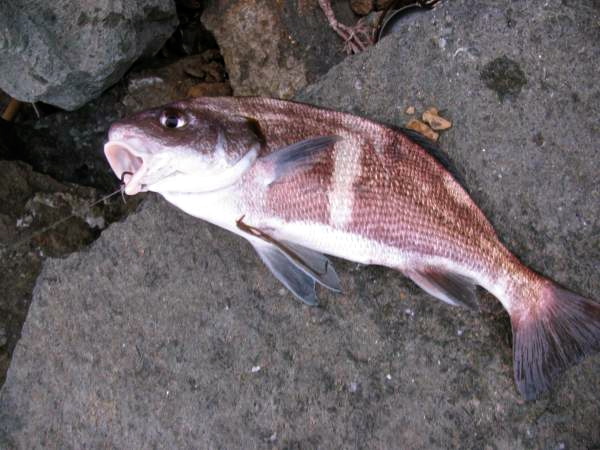Croakers—Family Sciaeidae
 A black croaker from the Oceanside Harbor Pier
A black croaker from the Oceanside Harbor Pier
Species: Cheilotrema saturnum (Girard, 1858); from the Greek word cheilotrema (lip pores) and the Latin word saturnum (dusky color).
Alternate Names: China croaker, Chinese croaker, Chinafin croaker and red roncador. Early names included black perch and black bass. Given the references to China croaker, it is called 黑唇孔石首魚 in Mandarin Chinese. In Mexico it’s called corvina roncacho or corvinata negra.
Identification: A very deep-bodied croaker that is recognized by the black edge on the upper opercle (gill cover) and the dark black-purple coloration. They usually have a pale bar at midbody. However, adults seem able to change color patterns dependent upon the environment. In open water, over sandy bottoms, they may be somewhat tan in color while over rippled sand they can assume a striped pattern. Large adults, black in color, move into dark caves, crevices and grottoes where they can be almost invisible. Juveniles may be yellow-white with several black horizontal bands on the upper portion of the body (and closely resemble juvenile sargo and salema). They have a blunt snout and the upper jaw projects over the lower jaw.
Size: Up to 16 inches although most caught off piers are less than 12 inches long. A 14-inch fish weighed 1 pound 9 ounces, and was 20 to 21 years old.
 A black croaker taken from the rocks in Mission Bay by geese in 2010
A black croaker taken from the rocks in Mission Bay by geese in 2010
Range: Bahia Magdalena, southern Baja California to Point Conception.
Habitat: Young like shallow-water areas with sandy bottoms, and are found along the open coast and in bays; adults are found in both sandy and rocky areas. Ranges down to 150 feet but generally found from 10 to 50 feet. Feeds primarily on rock dwelling crabs such as lumpy crabs, young masking crabs (spider crabs), and red-rock shrimp.
Piers: Black croaker are found at most southern California piers but are rarely caught; they are very shy and hide in caves and crevices most of the day. By the time they come out at night to move around and feed, there are less anglers around to catch them. Best bets: Embarcadero Marina Park Pier, Shelter Island Pier, Oceanside Harbor Pier, San Clemente Pier, Seal Beach Pier, Belmont Veterans Memorial Pier, Hermosa Beach Pier, and the Santa Monica Pier.
Shoreline: An infrequent catch by shore anglers in southern California.
Boats: A few are taken by boaters fishing the southern California bays.
 Another black croaker taken by geese from the rocks in Mission Bay in 2010
Another black croaker taken by geese from the rocks in Mission Bay in 2010
Bait and Tackle: Similar to most other croakers; use a high/low leader with number 6 to 4 hooks. Bait with sand crabs, clams, fresh mussels, ghost shrimp, shrimp, bloodworms, or innkeeper worms. The best area for black croakers is from the surf area to midway out on a pier.
Food Value: Similar to yellowfin croaker in taste and texture; eat only a limited amount in areas that are known to be polluted—and check for warning signs.
Comments: Black croaker are the least commonly caught croaker. It is reported that young black croaker, along with sargo and salema, lead extremely boring lives. All will school together just beyond the surf line in areas where there are rocks to provide protection against the surge of the surf. All will face directly into the surge and the schools will not shift position more than 10 feet during an entire season. However, within the schools, the size and numbers fluctuate from day to day. As the black croaker grow larger, they break away from the schools and begin to frequent caves and crevices (from boring to bleak). Illegal to buy or sell in California since 1933.















Hello,
I caught two black croaker off of Oceanside Pier on 02/03/19, using a high/low rig, #4 hook, and cut anchovy. Extremely rough swell and under current tow. Released both fish after pics taken.
Good job on the release. Ken